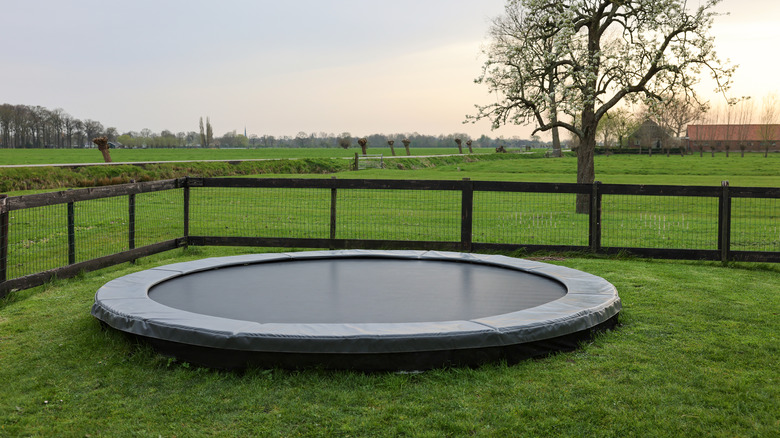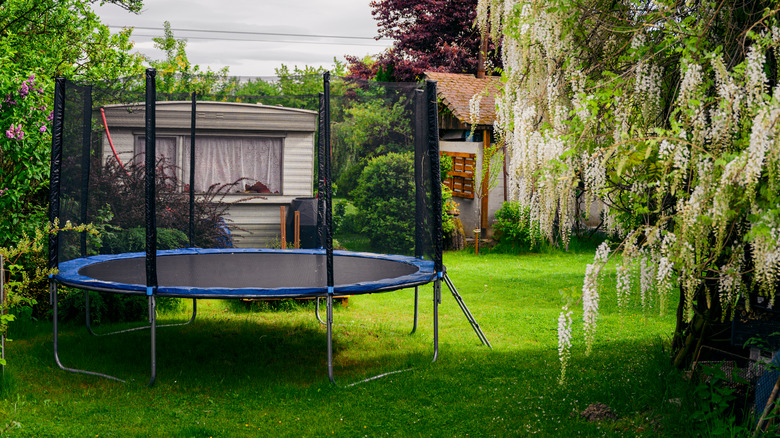Inground Vs Above Ground Trampolines: Is One Better?
Trampolines have long been an exciting and fun summer activity. Whether you are well into your adult years or are still in elementary school, trampolines never fail to make us laugh as we flail and bounce through the air. Shopping for the right trampoline is more complex than it seems, and there are a lot of factors to consider before making a large purchase. Before you even decide on sizes and brands, you'll find yourself choosing between an in-ground or above-ground trampoline. It's pretty self-explanatory, with in-ground versions being placed into the ground and above-ground being installed right on top of your lawn.
There are many pros and cons between inground and above-ground trampolines, and the right one for you will depend on how much you are willing to spend, where you live, and what safety measures you'd like to take. Generally speaking, you can expect to pay much more for inground trampolines between the installation and upkeep, but in return, you will receive a safer jumping experience. On the other hand, above-ground trampolines have some safety hazards and lawn maintenance complications. Yet, it's a better choice for those on a budget and looking for a less permanent setup.
Inground trampolines
Inground trampolines are more aesthetically pleasing as they're lower profile and won't be constantly in your eyesight when looking out into the yard. Additionally, you'll find that inground models tend to be safer, especially for pets and kids that are at risk of tumbling off the side after a powerful bounce. One can still install a safety net for embedded trampolines, but it's not as necessary as with an above-ground structure. With these benefits, you may already be headed to place your inground trampoline into the cart, but there are many other factors to consider beforehand.
While the trampoline itself won't necessarily be more expensive than an above-ground model, installing inground trampolines is invasive and, thus, an additional expense. You'll likely need to hire someone to install it or, at the very least, dig the hole, which can cost between $400 to $1500 for an average-sized trampoline. The exact cost of excavation will typically depend on how large the area is and how accessible the ground is. So, it's wise only to try and install something when the soil is at its softest. If you don't have an even surface to implement an inground trampoline, you probably shouldn't. Slopes and inclines complicate installation and can pose safety risks in the long run. Lastly, consider the upkeep an inground trampoline requires. A drainage system will need to be implemented to avoid flooding underneath, as well as attention to any pest infestations or wildlife looking to burrow underneath it.
Above ground trampolines
Above-ground trampolines are much more straightforward and easy to DIY. You won't need to consider extra installation costs and can plan to pay just the face value of the trampoline, which can be anywhere between $300 to $2500, depending on the size and model. Above-ground structures allow more mobility and are less permanent than inground, so if you are someone who rents, this would be the best option for you. The quality of bouncing you'll get with above-ground trampolines will also likely have more energy, as with inground versions, not as much air can escape from underneath, ultimately lessening the bounce.
Above-ground trampolines may be more affordable and less complex, but they are not necessarily as safe. You'll want to purchase a safety net with any above-ground model, as falling is a much higher risk and more dangerous than with inground trampolines. If you live somewhere with a lot of high winds, be aware that trampolines are known to fly in bad storms, damaging nearby property and often ruining the trampoline itself. Caring for your lawn with a trampoline hovering above it will also pose complications. As a trampoline mat repels sunlight and shelters from the rain, you'll likely find the grass underneath dying or growing faster than the rest of the lawn, depending on your climate. Mowing around and underneath trampolines can certainly be a hassle. But, overall, above-ground trampolines will work best for families looking to stay within budget and have a mobile setup.


